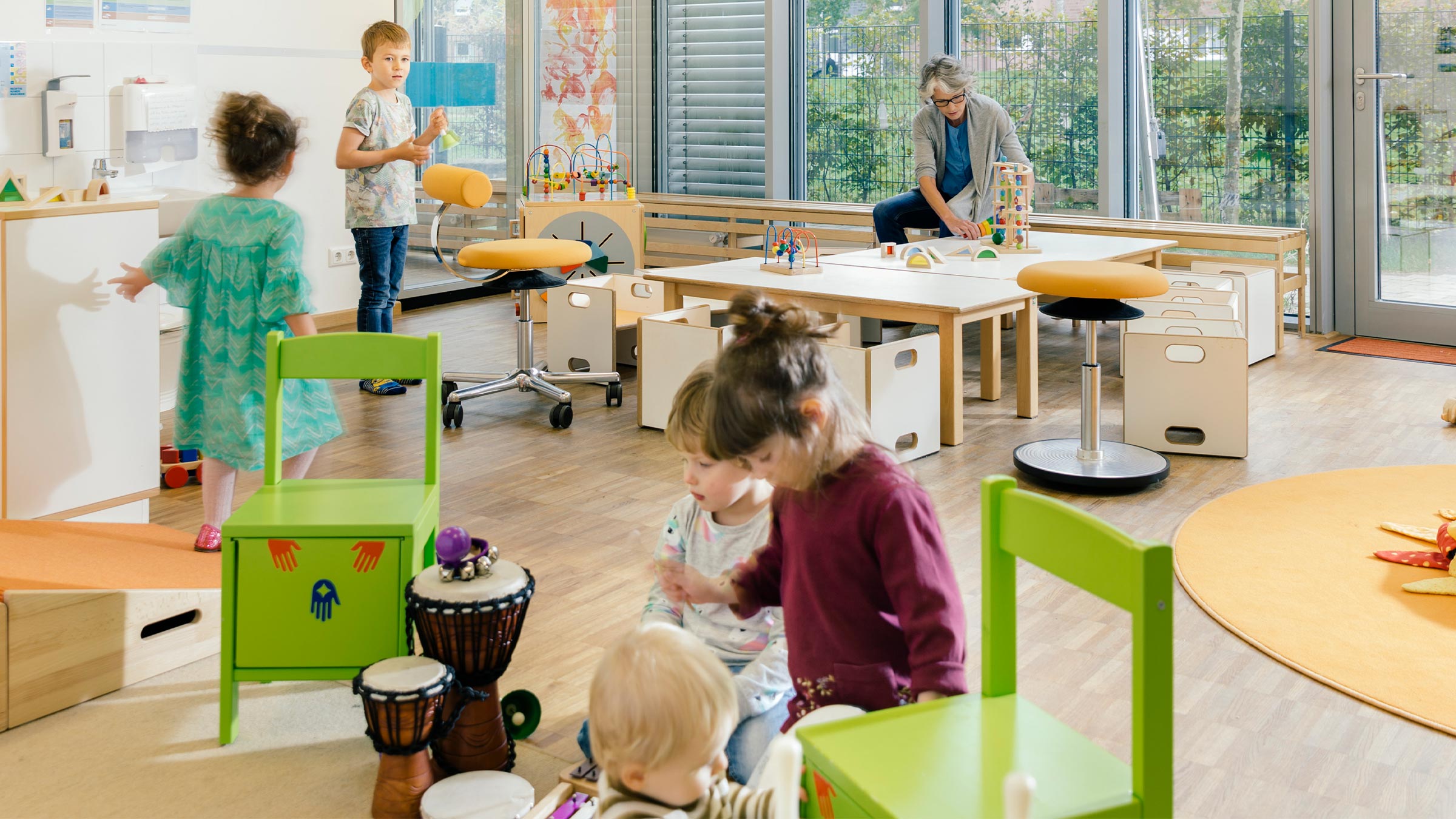Lori Thorp’s heart was aflutter when she learned that her son and daughter-in-law were expecting.
“I didn’t know how right that second, but the day that they told us, I knew that our lives would all change so much,” she said.
She would have a grandson to lavish attention on. That change was expected. What happened next wasn’t: She would retire early to provide child care full time.
In the Detroit Lakes, Minnesota, area where the family lives, child care providers have few if any openings for infants. Thorp said the expectant parents called more than a dozen without luck. “At one point, I said, ‘How do I apply for this position?’”
Discussions about child care tend to center on licensed providers, such as child care centers. But grandparents, other family members, friends, and neighbors have long been important parts of the child care ecosystem. Often, these “FFN” providers, as child care experts call them, care for just as many children as licensed providers.
In recent years, licensed care has become less affordable or available, especially in the pandemic. As a result, FFN providers have become more important for many parents, according to those who work with FFNs.
“Child care providers are the backbone of the workforce because, without them, parents wouldn’t be able to work,” said Deby Ziesmer, who works with FFN providers at the Minneapolis Youth Coordinating Board. “And more and more of those child care providers are family, friends, and neighbors.”
Shaped by circumstances
FFN care, also known as “informal” care, is a catch-all term for providers that are unregulated, usually because caregivers are close relatives or the number of children involved is very small.
That makes FFNs a diverse group. Where regulations and common business models tend to standardize licensed providers, FFNs are shaped by life circumstances.
Most FFNs nationwide and in the Ninth District are grandparents, according to U.S. census data (Figure 1). But FFNs often include other relatives and nonrelatives. In some cases, people already caring for related children may agree to care for unrelated children, too.
The vast majority of Midwestern FFNs were unpaid in 2019, according to the National Survey of Early Care and Education (NSECE). Of the 21 percent that were paid, more than half received less than $20 per week for all children. That’s far below the market average of $180 per week per child that licensed providers are paid, according to Child Care Aware.
NSECE results for the Midwest, which includes most Ninth District states, are very similar to national results.
“We don’t have a price for caring for children because we try to help other people,” said Ruth Evangelista, co-founder of La Red Latina de Educación Temprana, which advises Twin Cities Latino FFNs. She said that parents often pay what they can or even barter goods, such as groceries, for care.
For some Midwestern FFNs, providing care may be a step toward becoming a licensed provider. The NSECE found that 13 percent provided care because it’s a career they aspire to. FFN experts say many can’t do so because licensing requires a significant investment of time and money.
Most Midwestern FFNs don’t have another job, but among the 44 percent that do, half are balancing child care with full-time jobs, the NSECE found.
Providers with jobs usually work different hours than the parents and may be parents themselves, said Sue Monson, who manages the child care program at MAHUBE-OTWA Community Action Partnership in Detroit Lakes, Minnesota. “They barter with each other for hours of care. It’s like ‘I’m free at this time. If you’re working, I can take the kids.’”
Filling in the gap
One of the most common reasons parents turn to FFNs is the shortage of available or affordable licensed providers, according to FFN experts.
Demand for child care often exceeds licensed providers’ capacity, especially in rural areas and low-income neighborhoods. Many licensed providers also aren’t open during nontraditional working hours, such as swing shifts.
In 2023, there were 1.1 million children age 5 and younger with working parents in Ninth District states, including parts of those states outside the district, according to the U.S. Census Bureau. At that age, they’re too young to be home alone and, in most cases, to attend school. The licensed capacity of providers in these states was only enough to care for 75 percent of those children. Outside of metro areas, that ratio was 53 percent. Nationwide, the ratio is about 72 percent, according to licensing data gathered by Child Care Aware.
In practice, the ratio is significantly lower. Providers rarely operate at capacity, and licensed capacity includes children older than 5.
Publicly funded early childhood education programs, such as Head Start, care for some young children but not enough to make up the difference. Historic patterns suggest that the gap is covered by FFN providers.
“Parents need to have somewhere that they can take their kids,” Ziesmer said, who linked the shortage to providers going out of business.
Among licensed providers, most of the decline is with family child care (FCC) providers. These small, home-based businesses are the most affordable, and the most widely available in rural areas. Tuition can be much higher at the larger commercial child care centers (CCC) that are replacing them.
In 2024, the average tuition at CCCs in Ninth District states ranged from 20 to 100 percent higher than FCCs, according to Child Care Aware. Nationally, average tuition at centers was 29 percent higher.
“What you pay for one child to the child care center—it’s more than your mortgage,” Evangelista said.
The number of FCCs, however, has been declining. Between 2019 and 2023, Child Care Aware found a 12 percent decrease nationwide. In Ninth District states for which complete licensing data is publicly available, the decrease ranged from 5 to 21 percent.
As a result, parents who could only afford FCCs or who lived in rural areas faced long waiting lists for the remaining providers.
Zane Bail, an executive overseeing FFN programs at the Northland Foundation in Duluth, Minnesota, said licensed providers in her region say the worst shortage is in infant and toddler care. “They have a two-year waitlist for infant spots.”
The limits of informal care
While detailed data needed to establish long-term trends is not available for recent years, indirect evidence suggests FFNs have been and continue to be very important providers of child care. They were especially important in the pandemic years when many licensed providers closed.
For example, there is a clear gap between demand for care of young children and the supply of paid child care (which are primarily licensed businesses) and public programs (such as Head Start). Most of that gap is likely filled by FFNs.
Between 2010 and 2023, the gap fluctuated somewhat, narrowing before the pandemic and widening afterward (Figure 2). Nationally, the gap widened enough that it grew larger than paid child care. In Ninth District states, paid care was more important, but the size of the gap was about the same.
The gap between children in need of care and those in formal child care
Sources: U.S. Census Bureau, Annie E. Casey Foundation, Head Start, and National Institute for Early Education Research.
But even as FFNs grow in importance, some limitations affect their ability to substitute for formal care.
FFN providers often aren’t trained like their licensed counterparts in skills such as CPR and early childhood development. States and their nonprofit partners have tried to change this with outreach programs.
In Minneapolis, Ziesmer said her group focuses on high-poverty areas where kids are at risk of falling behind academically. “Our overarching goal is to make sure that all children enter kindergarten ready to succeed.”
FFNs often can’t provide care for as many hours as licensed providers, Census Bureau surveys have shown, perhaps because many hold other jobs. In that case, working parents must patch together care from different providers.
“It’s gotta be a village-type model,” said Taylor Holm, the child care program officer at Northland Foundation. When Holm and her husband couldn’t find licensed infant care, her mother-in-law agreed to help, but only a few days a week because she still works, Holm said. Luckily, her neighbor was able to help, she said.
And FFN care may require providers to sacrifice time and income. Researchers have found, for example, that the arrival of a new grandchild increases the likelihood that a grandmother will retire early or work fewer hours.
Thorp, who now cares for two grandsons, said her decision to retire early involved a lot of discussion with her husband about how they could afford it. But her sacrifice is balanced by the satisfaction she feels as a caregiver. “I would take photos throughout the day of fun things we did, even when they were infants,” she said, “because I love all ages. Every time I say, ‘This is my favorite stage,’ and then I think, ‘Oh, but yes, this other was so fun.’”
Tu-Uyen Tran is the senior writer in the Minneapolis Fed’s Public Affairs department. He specializes in deeply reported, data-driven articles. Before joining the Bank in 2018, Tu-Uyen was an editor and reporter in Fargo, Grand Forks, and Seattle.






